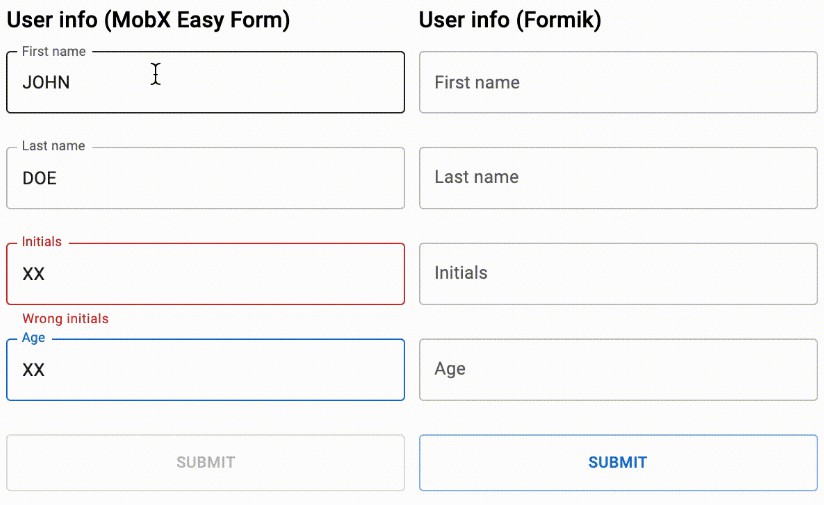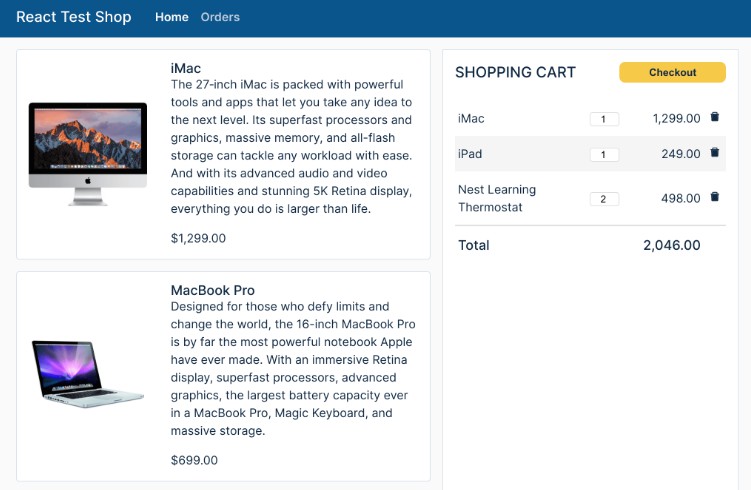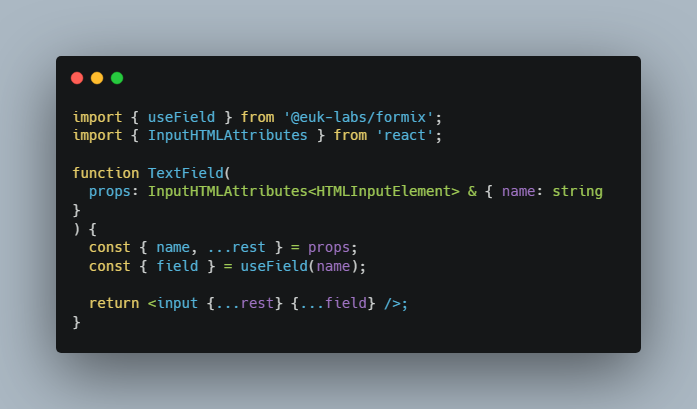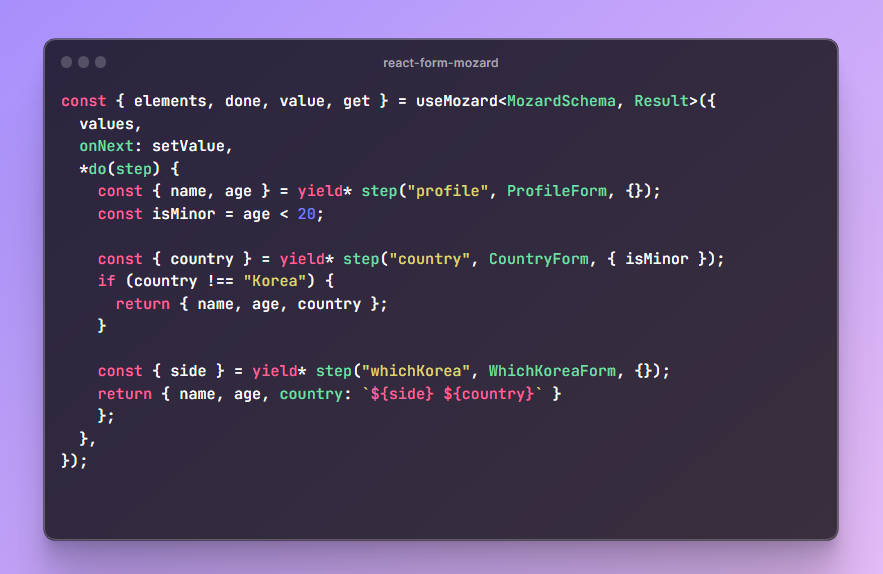MobX Easy Form
Simple and performant form library built with MobX.
Works with React, React Native and any other framework that supports MobX.
Motivation
This library is heavily inspired by Formik. I like Formik, but there are some issues with Formik that MobX Easy Form solves.
1. Performace
Forms can get very complicated. Formik can get slow as the form grows as it re-renders the whole form on every keystroke. There are available optimizations but it’s complex to setup and can introduce bugs like a field not rendering when it should.
MobX Easy Form solves this issue with MobX. It makes sure to re-render only the components that need to re-render.
You can see the difference in the following GIF. The number of times each component renders is shown below.
2. Validation limitations
Formik forces you to define the validationScheme and initialValues for all your fields at the same time, which means you can’t change the validation logic based on the value of some field.
With MobX Easy Form you define each field separately so you can use one field value to initialize another.
Installation
Installing the dependencies
MobX Easy Form depends on mobx, and if you’re using React, you’ll also need mobx-react-lite (or mobx-react if you support class components). To install these, run
npm install mobx mobx-react-lite
# if you use yarn
yarn add mobx mobx-react-lite
Installing MobX Easy Form
npm install mobx-easy-form
# if you use yarn
yarn add mobx-easy-form
Quick start with React
import { createField, createForm } from "mobx-easy-form";
import { Observer, observer } from "mobx-react";
import { useMemo } from "react";
import * as yup from "yup";
export default observer(function Form() {
const { form, firstName, lastName, initials, age } = useMemo(() => {
const form = createForm({
onSubmit({ values }) {
console.log("Values:", values);
},
});
const firstName = createField({
id: "firstName",
form,
initialValue: "",
});
const lastName = createField({
id: "lastName",
form,
initialValue: "",
});
const initials = createField({
id: "initials",
form,
initialValue: "",
validate(initials) {
if (
initials.length === 2 &&
initials[0] === firstName.state.value?.[0] &&
initials[1] === lastName.state.value?.[0]
) {
return { error: undefined, parsed: initials };
}
return { error: "Wrong initials", parsed: undefined };
},
});
const age = createField<string, number>({
id: "age",
form,
initialValue: "",
validationSchema: yup.number(),
});
return { form, firstName, lastName, initials, age };
}, []);
return (
<div>
<h1>User info</h1>
<Observer>
{() => {
return (
<div>
<div>First name</div>
<input
value={firstName.state.value}
onChange={(e) => firstName.actions.onChange(e.target.value)}
onFocus={() => firstName.actions.onFocus()}
onBlur={() => firstName.actions.onBlur()}
></input>
<div>{firstName.computed.ifWasEverBlurredThenError}</div>
</div>
);
}}
</Observer>
<Observer>
{() => {
return (
<div>
<div>Last name</div>
<input
value={lastName.state.value}
onChange={(e) => lastName.actions.onChange(e.target.value)}
onFocus={() => lastName.actions.onFocus()}
onBlur={() => lastName.actions.onBlur()}
></input>
<div>{lastName.computed.ifWasEverBlurredThenError}</div>
</div>
);
}}
</Observer>
<Observer>
{() => {
return (
<div>
<div>Initials</div>
<input
value={initials.state.value}
onChange={(e) => initials.actions.onChange(e.target.value)}
onFocus={() => initials.actions.onFocus()}
onBlur={() => initials.actions.onBlur()}
></input>
<div>{initials.computed.ifWasEverBlurredThenError}</div>
</div>
);
}}
</Observer>
<Observer>
{() => {
return (
<div>
<div>Age</div>
<input
value={age.state.value}
onChange={(e) => age.actions.onChange(e.target.value)}
onFocus={() => age.actions.onFocus()}
onBlur={() => age.actions.onBlur()}
></input>
<div>{age.computed.ifWasEverBlurredThenError}</div>
</div>
);
}}
</Observer>
<Observer>
{() => {
return (
<button
onClick={form.actions.submit}
disabled={form.computed.isError && form.state.submitCount > 0}
>
SUBMIT ({form.computed.isError ? "invalid" : "valid"})
</button>
);
}}
</Observer>
</div>
);
});
React Example on CodeSandbox
https://codesandbox.io/s/mobx-easy-form-example-xn3ss
React Native Example on Expo Snack
https://snack.expo.dev/@hrastnik/react-native—mobx-easy-form
Getting started
Create a form and define the onSubmit function.
const from = createForm({
async onSubmit({ values }) {
console.log(values);
},
});
Create some fields, and add them to the form by passing the created form to the createField parameter form. We also need an id and initialValue
const firstName = createField({
id: "firstName",
form,
initialValue: "",
});
The id is used to access when accessing the field through the form.
form.fields.firstName === firstName; // true
You can pass a validation function to createField but MobX Easy Form works really well with yup validation library and it’s the recommended approach.
const age = createField<string, number>({
id: "age",
form,
initialValue: "",
validationSchema: yup
.number()
.typeError("Age should be a number")
.required("Age is required"),
});
Note that we’re using TypeScript here and we’re passing 2 types to the createField generic. The first type is the type of the input value (the value passed to initialValue) and the second type is the output type that our validation function parses.
MobX Easy Form uses the validation function for two things:
- To check if the value is in the right format.
- To parse the value and convert it to something usable.
In the example above, the field state will hold the string value of a number – e.g. "42", but yup will convert it to a number 42 that we can access through age.computed.parsed and is also the value we get in the onSubmit({ values })
IMPORTANT!
The
createFormandcreateFieldfunctions will re-create the form on each render and you won’t be able to change the inputs – so you have to make sure it only gets created once. You should wrap it inuseMemoor even better –useMemoOne
Render
We can now render the inputs. A great performance optimization is to use the <Observer> component from mobx-react to limit the renders to only the input that needs to change. Alternatively you can create your own input component with the observer HOC.
Each field has the state,computed and actions props.
<Observer>
{() => {
return (
<div>
<div>First name</div>
<input
value={firstName.state.value}
onChange={(e) => firstName.actions.onChange(e.target.value)}
onFocus={() => firstName.actions.onFocus()}
onBlur={() => firstName.actions.onBlur()}
></input>
<div>{firstName.computed.ifWasEverBlurredThenError}</div>
</div>
);
}}
</Observer>
API
createForm
| parameter | type | required | description |
|---|---|---|---|
onSubmit |
(props: OnSubmitArg) => any; | true | Function that will be ran when form.actions.submitForm is called if the form is valid. |
Returns a Form instance.
OnSubmitArg
| parameter | type | description |
|---|---|---|
fields |
Record<string, Field>; | An object containing all the fields added to the form. Key’s are ids passed to the createField prop. |
rawValues |
Record<string, any>; | An object containing all the raw values from all the fields in the form. |
values |
Record<string, any>; | An object containing all the parsed values (returned from the validate or validated using the validation schema) from all the fields in the form. |
createField
| parameter | type | required | description |
|---|---|---|---|
id |
string | required | Unique identifier for the given field. When you add the field to a form, you can later access the field in form.fields.<id> |
initialValue |
any | required | The initial value of the field. If you’re using TypeScript, note that this field will be used to type the values you can set through onChange, so for optional fields consider using a cast to add the undefined type. (initalValue: "" as "" | undefined) |
form |
Form (return value of createForm) |
required | The form to which the newly created field should be added. |
validationSchema |
Yup.ValidationSchema | optional | Yup validation schema used to validate the field value. You can only set one of validationSchema and validate |
validate |
(value: any) => { error?: undefined, parsed: any } | { error: string, parsed?: undefined } | optional | Validation function used to validate and parse the value. It receives the value and must return and object with either error or parsed set |
initialError |
string | optional | Initial error for the field |
Returns a Field instance
Field
| parameter | type | description |
|---|---|---|
state.errorOverride |
string | undefined | Custom error message set on the field |
state.id |
string | id of the field |
state.isFocused |
boolean | true if the field is focused, false otherwise |
state.value |
any | Current value of the field |
state.wasEverBlurred |
string | true if the field was ever blurred, false otherwise |
state.wasEverFocused |
string | true if the field was ever focused, false otherwise |
computed.error |
string | undefined | Custom error message set on the field |
computed.ifWasEverBlurredThenError |
string | undefined | if the field was ever blurred returns the value of computed.error, otherwise returns undefined |
computed.ifWasEverFocusedThenError |
string | undefined | if the field was ever focused returns the value of computed.error, otherwise returns undefined |
computed.isDirty |
boolean | true if value is different from initialValue, false otherwise |
computed.parsed |
any | Parsed value of the field. The parsed value returned by validate or cast using the validation schema |
actions.onBlur |
() => void | Sets state.isFocused to false. Should be passed to text inputs onBlur |
actions.onChange |
(value: any) => void | Sets state.value to the provided value. Additionally, it clears the errorOverride if it was set |
actions.onFocus |
() => void | Sets state.isFocused to true. Should be passed to text inputs onFocus |
actions.setError |
(string | undefined) => void | Sets state.errorOverride to the provided value |
Form
| parameter | type | description |
|---|---|---|
state.isSubmitting |
boolean | true if the form is submitting, when the onSubmit function is async |
state.submitCount |
number | Number of times the form was submitted |
state.valuesAtLastSubmit |
string | undefined | Used internally. You shouldn’t use this |
computed.errorList |
[string | undefined] | An array of errors for all the fields |
computed.isChangedSinceLastSubmit |
boolean | true if any field has changed since last submit, false otherwise |
computed.isDirty |
boolean | true if any field is dirty (value different from initialValue) |
computed.isError |
boolean | true if any field has error different from undefined |
computed.isValid |
boolean | true if isError is false, false otherwise |
computed.valueList |
any[] | An array of all the values. Used internally, you shouldn’t use this. |
actions.add |
(field: Field) => void | Adds the provided field to the form |
actions.submit |
(value: any) => Promise | Sets isSubmitting to true, increases submitCount, for each field, sets the wasEverFocused and wasEverBlurred to true. Then, if isError is true does nothing, otherwise runs the onSubmit function |





